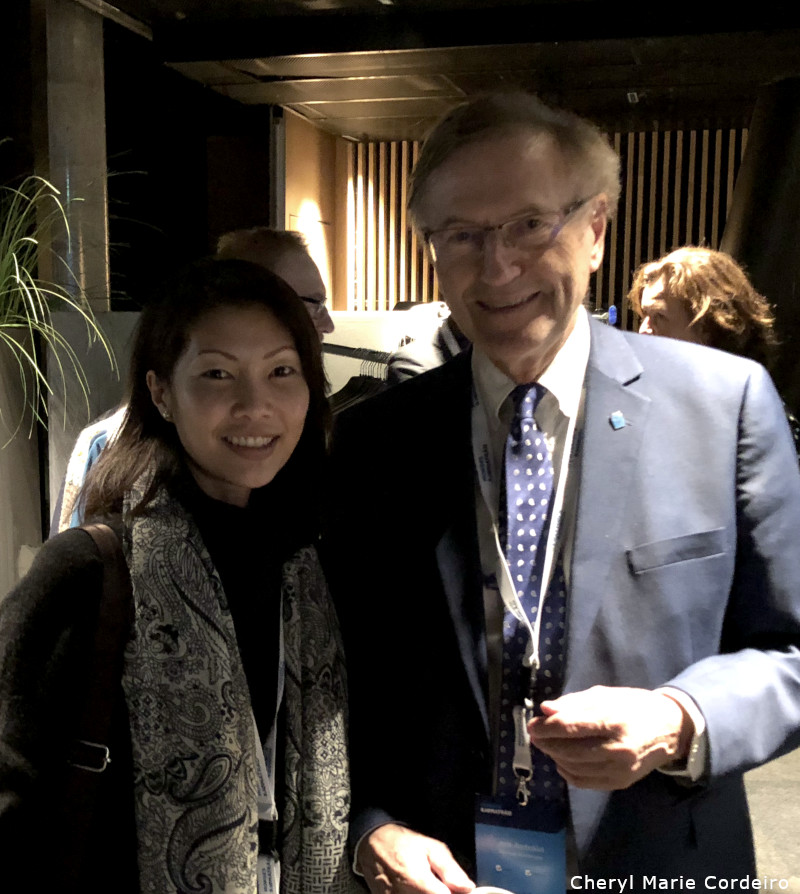At Torskefiskkonferansen 2018, I had the opportunity to meet and speak with Jarle Aarbakke, Norwegian politician with the Labour Party and current Deputy Mayor of Tromsø. He is also Professor Emeritus in Pharmacology (Medicine) at the Department of Medical Biology at the Faculty of Medicine at the University of Tromsø (UiT) and formerly served as Chancellor of UiT and the Higher Education Council. Mayor Jarle Aarbakke opened Torskefiskkonferansen 2018 with a Welcome Speech.
Text & Photo © CM Cordeiro 2018
Hosted by the Norwegian Seafood Council [1] who has its headquarters in the city known as Paris of the North, Torskefiskkonferansen 2018 was held in Tromsø, Norway, on Thursday, 18 Oct. 2018 at Clarion Hotel, The Edge. An important annual event for the cod fish industry sector of Norway, this year’s working theme for the conference was ”Torskefisk (Cod Fish) goes global!”. The purpose of the event was to provide a platform for the industry as well as academics to exchange knowledge and views on the continued development of the Norwegian cod fish industry and its position in global markets.
The general atmosphere of the conference was exciting and electric, with newspaper journalists and TV media present. The conference saw over 400 participants convene over this one day event, with top executives from companies such as Vesteraalens, Nergård and Lerøy present as keynote speakers as well as members of the audience. Representatives to this conference came from a span of various industry sectors including health and nutrients, fisheries management, fisheries technology, and academics researching the socio-economic impact of regional/global fish consumption. There were about nine keynote presentations, some of which had co-presenters. Norway’s Minister of Fisheries Harald T. Nesvik (Progress Party) in his keynote speech, addressed how Norway’s fisheries sector with its consistent focus and delivery on high quality products, could pave way as global exemplar of effective sustainable food resource management towards Agenda 2030.
A personal point of event highlight was to listen to the keynote speech entitled Great balls of Vesteraalens presented by Eirik Nikolaisen, who is Sales and Marketing Director for Vesteraalens AS. While research in fisheries management and market access often emphasize the interconnectedness and need for balance between fish resources and social welfare [2-4], Nikolaisen’s speech illustrated in concise manner, the company’s approach to product life cycle management towards low-waste and high quality products delivered globally. Nikolaisen’s presentation also illustrated a directed marketing strategy towards China, an emerging market in the region of East Asia with developing and evolving consumer preferences for fish products. Great balls of Vesteraalens could be said to put in sum of fishballs, an exemplar strategy of market access to mature as well as emerging markets for Norway’s fish products that considers not just evolving consumer preferences but a sustainable approach in providing for new markets.

Norway’s Minister of Fisheries Harald T. Nesvik (Progress Party), giving his keynote address on the future of Norwegian seafood. His portfolio includes responsibilities overseeing Norway’s fisheries and aquaculture management, seafood safety, health and welfare of fish, the framework conditions for seafood, as well as trade and market access for Norwegian seafood. In a separate interview with Norsk Sjømat magazine [5], Minister Nesvik acknowledges that there could be nothing more interesting than working with Norway’s growing seafood sector. Attention to fish quality and sustainable management of fish resources are important in supporting a strong culinary industry, where Norwegian Stockfish Gratin served with stewed almond potatoes and chorizo as his favourite piscatorial meal [5:10].
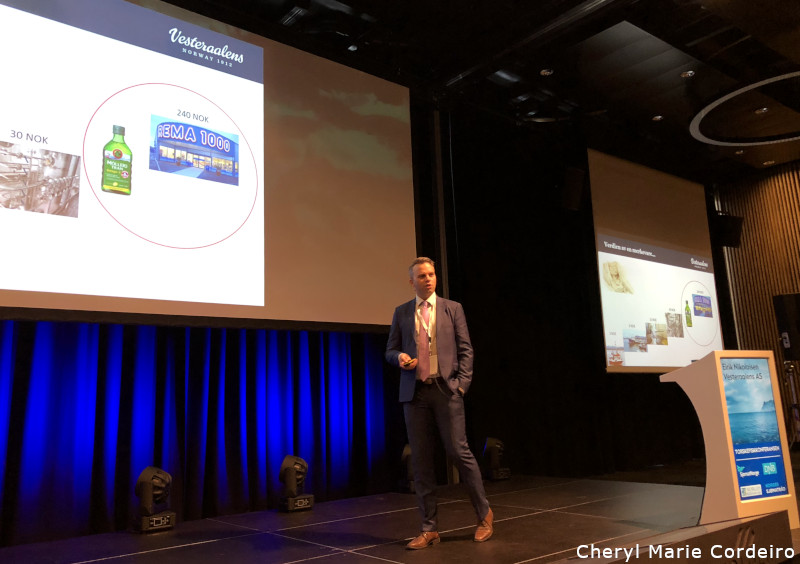
”Great balls of Vesteraalens”. Eirik Nikolaisen, Director of Sales and Marketing, Vesteraalens AS, speaks about Vesteraalens global value chain and emerging markets for their products of which China comes into focus.
While fishballs are not new in Chinese cuisine, the subtlety of flavour differences from Vesteraalens fishballs compared to locally produced fishballs has piqued gastronomic interests in China. Eirik Nikolaisen, in discussing Vesteraalens emerging market strategies, illustrates how a Chinese chef would put Vesteraalens fishballs to use in Chinese cuisine [6]. Pictured here is a powerpoint slide from Eirik’s talk, illustrating Vesteraalens fishballs wrapped and served in Chinese spring rolls.
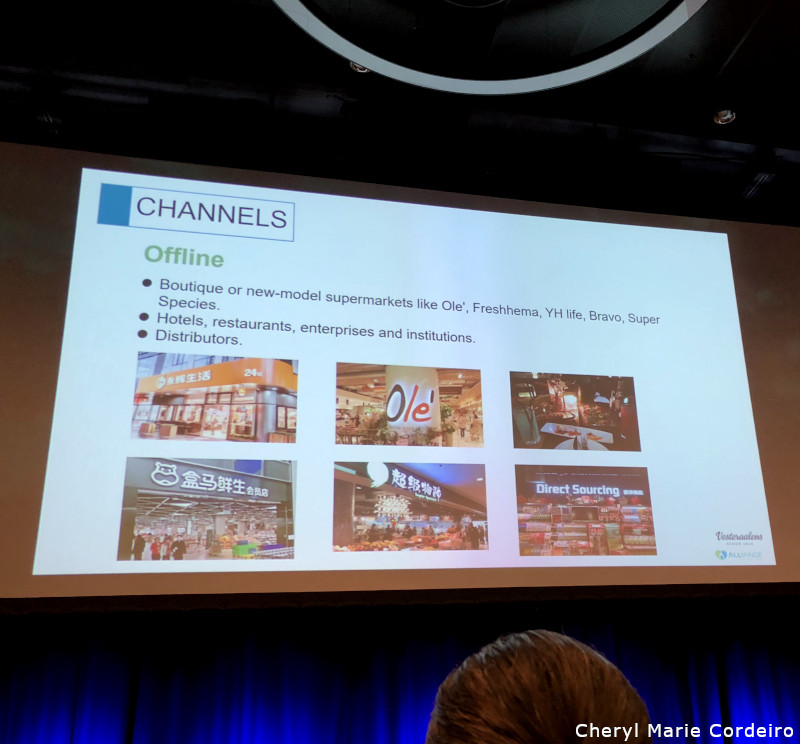
Some distribution channels in Vesteraalens product marketing strategy.
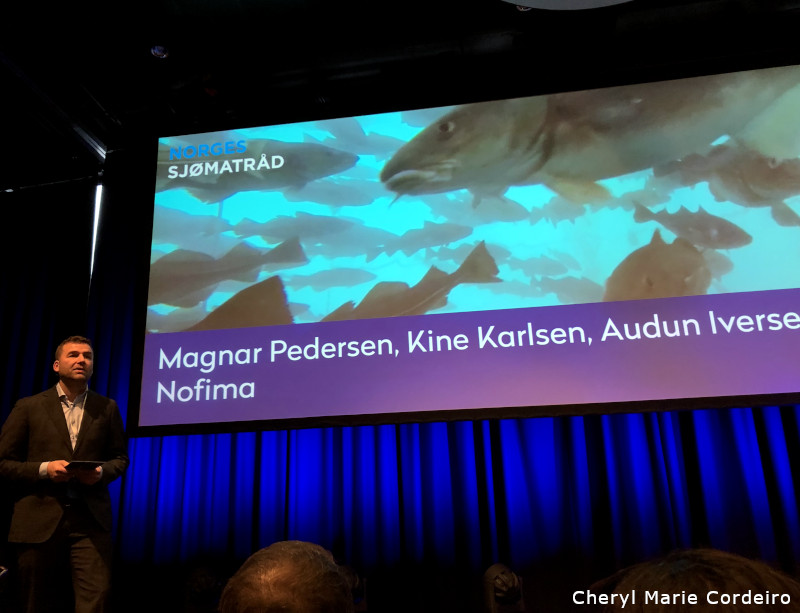
Ørjan Kjærvik Olsen (left), from the Norwegian Seafood Council was the event’s MC. He introduces here, keynote speakers from the Norwegian Institute of Food, Fisheries and Aquaculture Research (Nofima) included Kine Mari Karlsen, Audun Iversen and Magnar Pedersen. who addressed pressing issues of fisheries crime that can range in activities along the entire value chain of the fisheries sector.

Nofima Seafood Industry Division Director, Magnar Pedersen, speaking on the topic of fisheries crime. His speech raised awareness how the broad range of offences along the fisheries industry value and supply chain both on land and at sea can distort markets, harm the environment, negatively impact the economies of states and most of all, human social welfare due to eroding efforts at providing for future global food security.
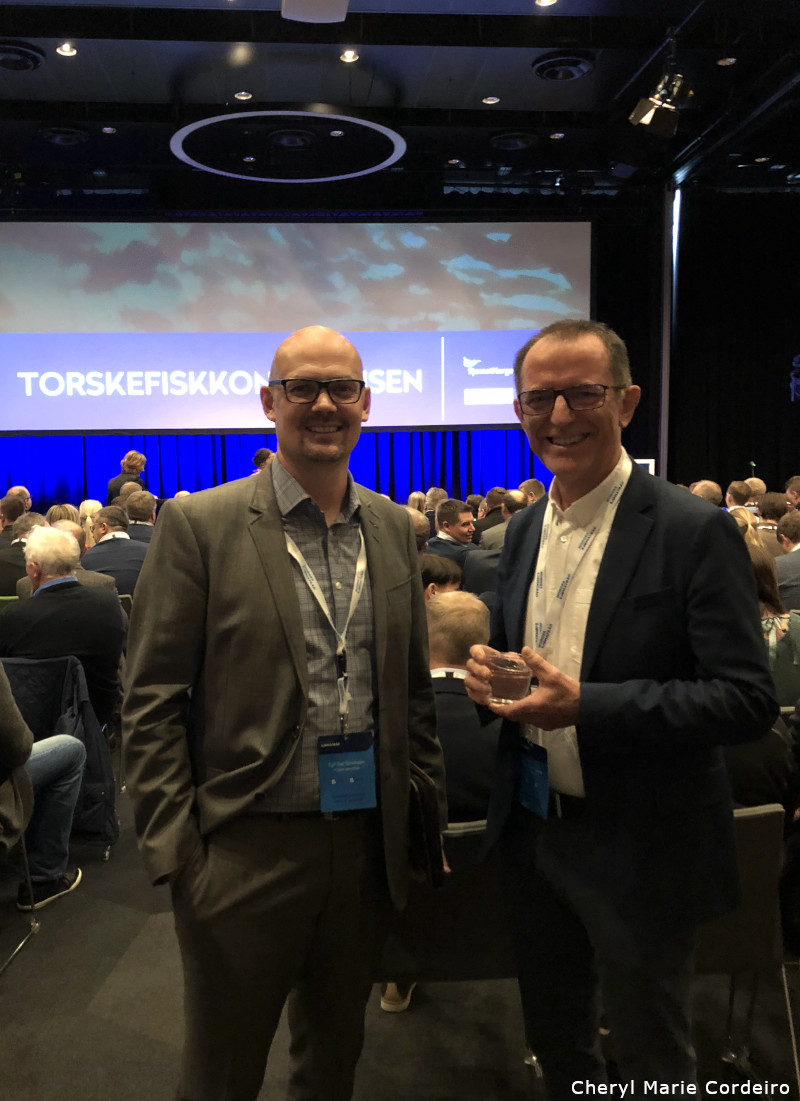
Egil Ove Sundheim (left), the Norwegian Seafood Council’s representative in the USA with Magnar Pedersen, Director for the Division of Seafood Industry at Nofima. Egil’s keynote speech revolved around the changing political climate in the USA with the Trump administration and its impact on global trade that includes Norway’s fisheries sector.
References
[1] The Norwegian Seafood Council (2018). Torskefiskkonferansen 2018. Internet resource at https://seafood.no/aktuelt/konferanser-og-seminarer/torskefiskkonferansen-2018/. Retrieved 19 Oct. 2018.
[2] Nielsen, M., Andersen, P., Ravensbeck, L., Laugesen, F., Kristófersson, D.M. & Ellefsen, H. (2017). Fisheries management and the value chain: The Northeast Atlantic pelagic fisheries case. Fisheries Research, 186, 36-47.
[3] Havice, E., & Campling, L. (2017). Where Chain Governance and Environmental Governance Meet: Interfirm Strategies in the Canned Tuna Global Value Chain. Economic Geography, 93(3), 292-313.
[4] Hamilton-Hart, N. & Stringer, C. (2016). Upgrading and exploitation in the fishing industry: Contributions of value chain analysis. Marine Policy, 63(C), 166-171.
[5] Ringheim, G. (2018). Den nye Fiskerisjefen, Norsk Sjømat 5-2018. Sjømatbedriftene, pp. 8-11.
[6] Nikolaisen, E (2018). Great balls of Vesteraalens. Keynote speech presentation at Torskefiskkonferansen 2018, Clarion Hotel The Edge, 18 Oct. 2018. Internet resource at https://seafood.no/aktuelt/konferanser-og-seminarer/torskefiskkonferansen-2018/. Retrieved 19 Oct. 2018.
